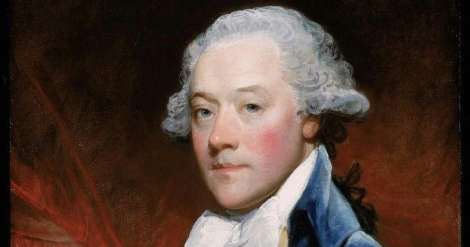Marie Antoinette and Maine hardly trip off the tongue together, but an intrepid ship captain from the state nearly saved the life of the French queen.
She was awaiting trial in prison in 1792 when Stephen Clough of Wiscasset arrived at the French port in Havre with a load of lumber aboard the ship Sally.
Clough was working for James Swan, a former colonel in the American Revolution. Swan had emigrated from Scotland to Boston and succeeded at trading, particularly with France.
Swan held large tracts of land in Virginia. He also acquired a group of islands off the coast of Maine, including Swan’s Island. In the 1780s, he faced mounting debts, so he turned to his old friend the Marquis de Lafayette for help. Lafayette arranged for him a profitable post supplying goods, including timber, to the French military.
By 1792, however, France had fallen into disarray. Revolutionaries were toppling the monarchy and Lafayette fell from favor.
Stephen Clough’s ship, Sally, and cargo were waylaid. While Clough tried to sort out what was going on, the king’s supporters noticed his vessel. They then began to plot.
Fate of Marie Antoinette
Political factions argued over the fate of the king and the queen, imprisoned in August and stripped of their titles in September.
Moderates urged they be allowed to live, while radicals wanted them executed. The idea of exile in America came up, and it appealed to Swan.
Jean Pierre de Batz (or de Bance), Baron de Sainte-Croix, was searching for a way to rescue the royal family. He and Alexandre Gonsse de Rougeville, another counter-revolutionary, came up with a plan and approached Clough.
They would arrange for the release of his ship and payment for his cargo, and in return he would ferry the royal family to America. Clough accepted the offer and, as his ship lay in the harbor, he began surreptitiously loading it with items for the royal family – furnishings, rugs, tapestries, china, etc.
King Louis XVI and Queen Marie Antoinette remained popular in America, warmly remembered for their support of the colonies in the war with England. Though Catholic, they would still have friends in the new country.
Time was running out, however. The revolutionaries got the trial of the king they wanted in January of 1793. A group of 721 men controlled his fate, as they voted on whether he should be executed. When the voting ended, 361, the minimum needed, voted for execution. Louis XVI fell to the guillotine.
The sentiment against Marie Antoinette was now growing more hostile. Once imprisoned, the king, queen, and their two children had all been held separately. Marie Antoinette was increasingly despised. Her profligacy, gambling and expensive tastes were all resented by an impoverished nation struggling with massive debts.
Let Them Eat Cake — Not!
The propagandists worked overtime to blacken her name further. They created the story that when informed that peasants were starving for lack of bread, she replied, “Let them eat cake.” The queen never did say that. In fact, the story had been created and used against others before her, but the legend stuck to Marie Antoinette.
The radicals began looking for more ways to slander her. They came up with spurious charges, including that she abused her son. Her supporters realized they needed to act quickly. In July or August, they sent word to her in prison that they were planning her escape. They planned to have a guard take her to the door of her prison where a carriage would meet her and take her to Clough’s ship. The message was sent in a note wrapped around the stem of a carnation flower.
She managed to reply in writing by using a pin to prick holes in the paper. Now, sick with tuberculosis and, some researchers believe, cancer, she was ready to leave France.
The plot backfired badly, however, as one of the guards got cold feet and revealed the note to his superiors. The revolution was by now spinning out of control. The radical elements of the revolution began to turn on the moderates, and the Reign of Terror got underway. Tens of thousands would be slaughtered before it ended.
After the plot, dubbed the carnation conspiracy, was discovered Marie Antoinette’s captors had even less sympathy. They locked her in a stronger cell and guarded her even more closely.
Maine Waits For A Queen
Clough had managed to tell his wife to prepare for meeting the queen, and by some accounts many in Maine were working out a proper reception. He had warned that, far from being the glamorous queen they expected, they should prepare for a very weak and sickly woman.
It’s not altogether clear that the plan called for the royal family to remain in Maine or even New England. Some accounts suggest that Swan actually intended to create a colony on his Virginia lands for French exiles.
With the French conspirators now on the run, Clough began to realize that the chances of completing the escape were slim. In October, Marie Antoinette went to trial. Her famous head of hair was cut off to give the guillotine a clear shot at her neck, and she was executed. Her body was dumped into an unmarked grave. It remained there until the monarchy was reestablished more than 10 years later.
Some accounts say Clough was among the crowd of thousands who witnessed the execution of Marie Antoinette. After her death, he hastily put to sea, lest he be discovered as a collaborator.
The French furnishings that Clough assembled were distributed among the Americans who had supported the plan. Many wound up with the Swan household in Boston (now in the Museum of Fine Arts). Others went with Clough to Wiscasset, Edgecomb and Westport. Some wound up in Henry Knox’s Thomaston mansion, probably via his son-in-law who was one of Swan’s sons.
Stories of the attempted rescue of Marie Antoinette made the rounds for years. Clough, moved by the experience, named a daughter after her.
This story about Marie Antoinette was updated in 2022.




4 comments
I have seen her house many times. It is in North Edgecomb Maine.
Bonjour madame,
Pourrais-je entrer en contact avec vous concernant cette maison.
Merci
Cordialement
[…] here, something a bit more […]
[…] he was too tyrannical in his ways. After spending the night in the same chamber used to jail Marie Antoinette, Robespierre was taken to the guillotine to be included among a score of French citizens who would […]
Comments are closed.